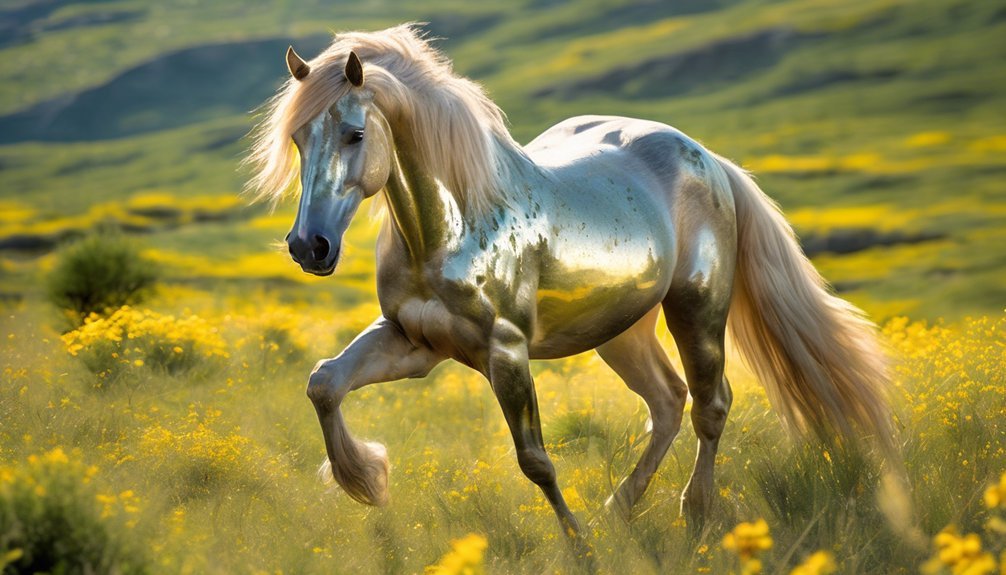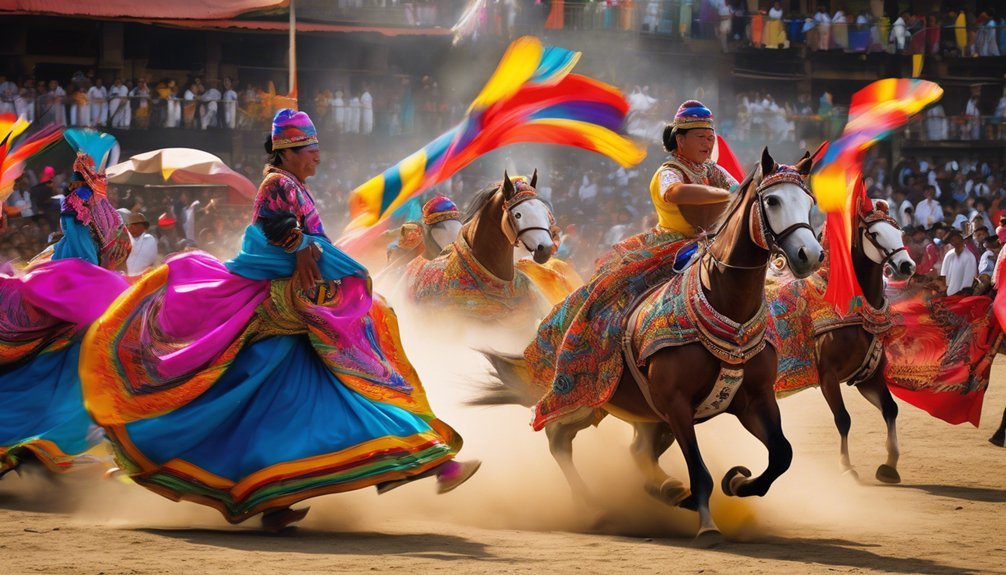
Is it true that a horse's coat color can reveal its genetic history? This idea opens up a fascinating exploration of equine genetics, where specific genes dictate coat colors and patterns. By understanding these genetic influences, you can gain insights into the characteristics and potential of different breeds. Yet, the complexity of color inheritance and the role of dilution genes might surprise you, prompting further inquiry into the rich tapestry of horse aesthetics.
Key Takeaways
- Horse coat colors result from genetic interactions involving key genes like Agouti, Extension, and Cream Dilution, which determine pigmentation.
- Common horse colors include bay, chestnut, black, gray, and palomino, each with distinct genetic backgrounds and traits.
- Patterns such as Overo, Tobiano, and Appaloosa demonstrate the diversity of horse appearances influenced by genetic factors.
- Environmental factors, including season, nutrition, and grooming, can significantly affect a horse's coat color and texture.
- Genetic testing is advancing, enabling breeders to identify color genes and enhance breeding practices for desired traits and patterns.
Understanding Equine Genetics

Understanding equine genetics is crucial if you want to grasp the complexities behind horse colors and patterns.
Equine color genetics delves into how specific genes influence a horse's coat. You'll find that inheritance patterns aren't random; instead, they follow specific rules dictated by dominant and recessive traits.
For instance, a horse's coat color can be a direct result of the genetic contributions from both parents, shaping everything from bay to palomino.
The Basics of Coat Color Inheritance
When you explore the basics of coat color inheritance in horses, you'll discover how specific genes interact to produce a variety of colors and patterns. Understanding these inheritance patterns is essential for breeders and horse enthusiasts alike.
Here's a quick look at some key coat color basics:
| Gene Type | Effect on Color |
|---|---|
| Agouti | Controls black vs. bay |
| Extension | Determines black pigment |
| Cream Dilution | Lightens base colors |
These genes can combine in various ways, leading to the rich tapestry of colors you see in horses today. By grasping how these inheritance patterns work, you can better predict and appreciate the stunning array of equine coat colors.
Common Horse Colors and Their Characteristics
In understanding common horse colors, you'll notice solid color variations and distinct patterns that can influence a horse's appearance.
Each color and marking carries unique genetic traits, reflecting the underlying inheritance patterns.
Solid Color Variations
Solid color variations in horses exhibit a rich spectrum of hues, each with distinct characteristics that can influence their appearance and behavior. Understanding solid color genetics and the factors that contribute to color variations is essential for horse enthusiasts like you. Below is a table summarizing common solid colors and their traits:
| Color | Characteristics |
|---|---|
| Bay | Reddish-brown with black points |
| Chestnut | Reddish to brown, no black points |
| Black | Deep, true black, often shines |
| Gray | White or gray with age, skin dark |
| Palomino | Golden coat, white mane and tail |
Each color not only adds beauty but can also reflect temperament and health, making your choice of horse even more meaningful.
Patterns and Markings
While solid colors provide a foundation for equine aesthetics, patterns and markings add unique flair and individuality to horses.
You'll encounter various marking types, each contributing to a horse's distinct appearance. Common markings include blazes, socks, and spots, which can appear in a multitude of color patterns, like pinto or roan.
These markings not only enhance visual appeal but can also serve practical purposes, helping to identify horses in a herd. Understanding these patterns allows you to appreciate the rich diversity in the equine world.
Each horse's unique combination of color and markings tells a story, reflecting its lineage and personality, making every encounter with them a personal experience.
Genetic Color Inheritance
Understanding genetic color inheritance is crucial for anyone interested in horse breeding or simply appreciating the diversity of horse colors.
The nuances of color inheritance are determined by genetic markers that dictate specific traits.
Here are some common horse colors and their characteristics:
- Bay: Rich reddish-brown with a black mane and tail.
- Chestnut: Reddish-gold, lacking black hair.
- Black: Solid black coat, sometimes with fading in the sun.
- Grey: White or gray coat that lightens with age.
- Palomino: Golden coat with a white mane and tail.
Patterns: The Unique Markings of Horses

Horses are often distinguished not just by their colors but also by the unique patterns that adorn their coats. These coat patterns can tell you a lot about a horse's lineage and characteristics. Understanding these unique markings can enrich your appreciation for these majestic animals.
| Pattern Type | Description | Example Breeds |
|---|---|---|
| Solid | Uniform color throughout | Thoroughbred |
| Overo | Irregular, jagged edges | Paint Horse |
| Tobiano | Smooth, rounded patches | Paint Horse |
| Appaloosa | Spotted, often on a solid base | Appaloosa |
| Roan | Mixture of colored and white hairs | Quarter Horse |
The Role of Dilution Genes
Dilution genes play a crucial role in determining a horse's coat color by lightening the base shades.
You'll encounter various types of dilution genes, each producing distinct effects on the horse's appearance.
Understanding these genetic factors is essential for predicting and recognizing the wide range of colors in equines.
Types of Dilution Genes
Though often overlooked, dilution genes play a crucial role in determining a horse's coat color and pattern.
Understanding the various dilution gene types helps you appreciate their effects on pigmentation:
- Cream: Lightens red and black coats, creating palominos and buckskins.
- Champagne: Produces a golden hue, affecting both base color and skin pigmentation.
- Dun: Dilutes colors while adding a characteristic dorsal stripe.
- Silver: Darkens black coats, giving them a distinctive silver sheen.
- Pearl: Affects both chestnut and black coats, often resulting in a unique, lighter appearance.
Each gene contributes uniquely, highlighting the complexity of equine color genetics.
Recognizing these types deepens your understanding of the beautiful diversity in horse coats.
Effects on Coat Color
Understanding how dilution genes affect coat color can significantly enhance your appreciation of equine diversity.
These genes subtly alter pigmentation, creating a spectrum of shades that range from palomino to buckskin. You might notice how these colors can also influence coat texture; a horse's coat may appear softer or shinier due to specific dilution effects.
Interestingly, seasonal changes can further modify this appearance, as the coat grows thicker or thins out with the weather. In winter, a horse's color may darken, while summer can bring out lighter hues.
The Influence of Breed on Color and Pattern
When exploring horse colors and patterns, it becomes clear that breed significantly influences these traits. Each breed carries unique characteristics that dictate the breed color distribution you observe.
Here are a few key points to consider:
- Historical breed colors shape what you see today.
- Breed specific patterns often emerge from selective breeding practices.
- Genetic diversity effects play a role in available color variations.
- A breed influence analysis reveals how genetics dictate color outcomes.
- Breed characteristics comparison can help you understand regional color preferences.
Genetic Testing for Horse Colors
As you delve into the world of horse colors, genetic testing emerges as a powerful tool for identifying specific color genes and patterns.
Through coat color testing, you can uncover genetic markers that dictate a horse's unique appearance. This testing not only helps breeders select for desired traits but also allows you to understand the inheritance of certain colors in future offspring.
By analyzing DNA samples, you gain insights into dominant and recessive genes, making it easier to predict coat colors and patterns.
Whether you're a breeder, owner, or enthusiast, embracing genetic testing deepens your appreciation for the complexity of horse colors, ensuring a more informed approach to breeding and showcasing these magnificent animals.
The Impact of Environment on Coat Appearance

While genetics play a crucial role in determining a horse's coat color, environmental factors can significantly influence its appearance. You mightn't realize how much these elements shape your horse's look:
- Seasonal changes can lighten or darken coats.
- Light exposure affects pigmentation, leading to variations.
- Habitat conditions, like humidity and temperature, influence the coat's texture.
- Nutritional influences from diet impact overall coat health and sheen.
- Grooming practices can remove dirt and enhance color vibrancy.
Geographic variations and climate effects further contribute to these changes.
Historical Significance of Horse Colors
Understanding how environment affects your horse's coat can lead to a deeper appreciation of its historical significance. Colors often carry cultural symbolism, enriching the bond between you and your horse. For instance, certain shades were favored in historical breeds for their perceived qualities, like strength or beauty.
| Color | Cultural Symbolism |
|---|---|
| Black | Power and Nobility |
| Chestnut | Vitality and Energy |
| Grey | Wisdom and Age |
| Palomino | Wealth and Prosperity |
Each color tells a story, reflecting the values of different cultures. By recognizing these meanings, you can connect more intimately with your horse's heritage and the rich tapestry of equine history.
The Future of Horse Color Genetics
With advancements in genetic research, the future of horse color genetics is poised for significant transformation.
As you explore this evolving field, you'll discover exciting future predictions shaped by genetic advancements:
- Enhanced understanding of pigment genes
- Development of precision breeding techniques
- Potential for creating unique color patterns
- Improved health and temperament insights linked to color
- Greater accessibility to genetic testing for breeders
These innovations won't only deepen your appreciation for horse colors but also revolutionize breeding practices.
You'll have the opportunity to make informed decisions, ensuring the vibrancy and diversity of equine aesthetics.
As this field progresses, staying informed will help you connect with the growing community of horse enthusiasts and breeders who share your passion.
Frequently Asked Questions
Can Horse Colors Change as They Age?
Yes, horse colors can change as they age due to age-related changes and genetic factors. You'll notice variations in shades, patterns, or even the presence of gray, reflecting their unique genetic makeup and life experiences.
How Do Nutrition and Diet Affect Coat Color?
Imagine a painter's palette; without the right colors, the masterpiece fades. Similarly, if you neglect your horse's nutrition, deficiencies can hinder pigment production, altering their coat's vibrancy and overall health. Feed wisely for brilliance.
What Are the Rarest Horse Colors?
The rarest horse colors include the isabella horse, a soft cream hue, and the perlino horse, characterized by a pale coat and blue eyes. These unique colors result from specific genetic combinations, making them highly sought after.
Are Certain Colors More Prone to Health Issues?
Think of color as a window to a horse's health. Certain colors can indeed indicate genetic predisposition to specific health issues, influenced by color genetics. You should consider these factors when evaluating a horse's overall well-being.
How Do Weather Conditions Influence Coat Appearance?
Weather conditions significantly impact your horse's coat appearance. Seasonal changes can enhance or dull colors, while humidity effects might cause coat texture variations. Understanding these influences helps you maintain your horse's optimal look and health.
Conclusion
So, while you might think a horse's color is just a pretty coat, it's actually a fascinating tapestry of genetics and history. Each shade and pattern tells a story, revealing intricate relationships that go beyond mere aesthetics. Ironically, the more you dig into these colors, the more you realize that they're not just about beauty; they're about heritage, identity, and the science behind what makes each horse unique. The future of horse color genetics is as colorful as the horses themselves.





